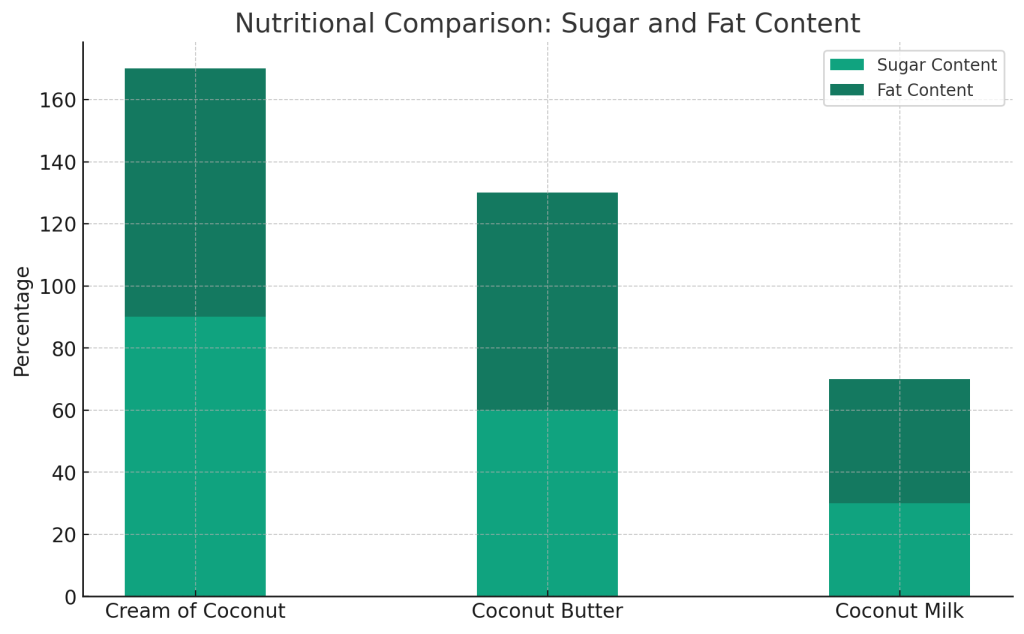Unveiling the Mystique of Cream of Coconut: A Culinary Gem
Cream of coconut, often shrouded in mystery, is a culinary marvel that deserves a spotlight in the kitchen. This luscious ingredient, pivotal in creating a myriad of tropical and exotic dishes, holds a unique place in the culinary world.
The Visual and Textural Appeal of Cream of Coconut
Cream of coconut is known for its striking resemblance to regular cooking cream, albeit with a slightly whiter hue. Its texture mirrors that of traditional cream, but with a looser, syrupy consistency that sets it apart. When you delve into a can of coconut cream, you’ll often find a layer of solid white material at the top. This is the cream’s pièce de résistance, rich in both fat and protein, sitting atop a more liquid, milky layer.
The Sweet Symphony of Cream of Coconut
Unlike its close relatives, coconut cream and coconut milk, cream of coconut is celebrated for its sweet, luxurious taste and intense coconut flavor. This sweetness is achieved by blending coconut cream with a generous amount of sugar. This concoction results in a product similar to what condensed milk is to regular milk, offering a rich and intense flavor profile. It is a go-to ingredient for mixed drinks and ice creams where a deep, sweet coconut flavor is desired.
A Versatile Ingredient
Cream of coconut’s versatility is unmatched. It finds its way into a plethora of recipes, enhancing them with its unique sweetness and rich texture. From being a key component in tropical cocktails to adding a twist to traditional desserts, its applications are endless. This ingredient is not just about taste; it’s about transforming a dish into something extraordinary.
The Nutritional Side of Cream of Coconut
While cream of coconut is a treat for the taste buds, it’s important to consider its nutritional aspects. Being rich in sugar, it’s advisable to use it judiciously, especially if you’re monitoring your sugar intake. However, it’s an excellent alternative for those looking to add a vegan or lactose-free element to their dishes without compromising on flavor.
Tables of Comparison: Cream of Coconut vs. Its Counterparts
| Ingredient | Sweetness | Consistency | Usage |
|---|---|---|---|
| Cream of Coconut | High | Syrupy | Cocktails, Desserts |
| Coconut Cream | Moderate | Thick | Cooking, Baking |
| Coconut Milk | Low | Liquid | Soups, Sauces |
As seen in the table, cream of coconut stands out with its high sweetness and unique consistency, making it an ideal choice for specific culinary applications.
The Journey of Cream of Coconut: From Tree to Table
Understanding the origins of cream of coconut enhances our appreciation for this remarkable ingredient. The journey begins with the coconut tree, a natural wonder predominantly found in tropical and subtropical regions. These trees are characterized by their tall, slender trunks and feathery leaves, with the coconut as their prized fruit.

Inside the Coconut: A Treasure Trove of Ingredients
The coconut itself is a marvel of nature, offering more than just the cream. When exploring the contents of a coconut, one discovers an array of products like coconut water, meat, oil, and milk, each with its distinct use and benefits.
From Coconut to Cream: The Process
The process of creating cream of coconut involves extracting the rich, creamy substance from the coconut meat. This is often achieved through a method of grating and pressing the meat, followed by an addition of sugar to enhance its sweetness and texture. The result is a thick, sweet cream that is both versatile and indulgent.
The Nutritional Profile of Cream of Coconut
While indulging in the sweet, rich flavor of cream of coconut, it’s crucial to be mindful of its nutritional aspects. Coconuts are known for their nutritional benefits, including essential nutrients like potassium, magnesium, and fiber. However, the added sugar in cream of coconut means it should be consumed in moderation, especially for those watching their sugar intake.
Healthier Alternatives: Coconut Butter and Milk
For those seeking healthier coconut-based alternatives, coconut butter and coconut milk are excellent choices. Coconut butter, made from pureed coconut meat, offers a creamy texture and subtle sweetness suitable for various culinary uses. Meanwhile, coconut milk, with its lighter consistency and flavor, is perfect for soups and curries.
Comparing Nutritional Values: Cream of Coconut vs. Alternatives
| Ingredient | Sugar Content | Fat Content | Best Used For |
|---|---|---|---|
| Cream of Coconut | High | High | Sweet Dishes, Cocktails |
| Coconut Butter | Moderate | High | Cooking, Baking |
| Coconut Milk | Low | Moderate | Soups, Sauces |
The table above illustrates how cream of coconut compares nutritionally to other coconut products, highlighting its high sugar and fat content.
Embracing Cream of Coconut in Your Kitchen
Embracing cream of coconut in your kitchen opens up a world of culinary possibilities. From creating decadent desserts to crafting exotic cocktails, this ingredient can elevate ordinary recipes into something truly special. Whether you’re a professional chef or a home cook, experimenting with cream of coconut is a delightful journey worth embarking on.
Recipe Ideas Featuring Cream of Coconut
- Tropical Cocktails: Add a splash of cream of coconut to create creamy, flavorful drinks like Piña Coladas.
- Desserts: Use it in baking to add a rich, coconut flavor to cakes and pastries.
- Vegan Delights: Incorporate it into vegan recipes as a dairy substitute for a luxurious texture.
Conclusion
Cream of coconut is more than just an ingredient; it’s a gateway to exploring new flavors and textures in cooking and baking. Its unique properties and indulgent taste make it a must-try for anyone looking to add a tropical twist to their culinary repertoire.

